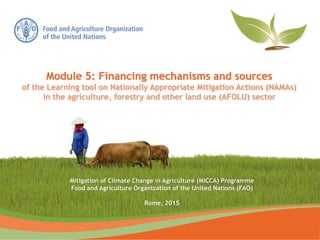The document discusses financing mechanisms and sources for Nationally Appropriate Mitigation Actions (NAMAs) in the agriculture, forestry, and other land use sector. It outlines that NAMAs require financing for implementation which can come from domestic public and private sources as well as international sources. Some key international sources discussed include the Green Climate Fund, NAMA Facility, and Global Environment Facility. Criteria for financing from these sources include demonstrating mitigation potential and support for sustainable development. Examples are provided of NAMAs in countries like Costa Rica and Mongolia that have received financial support.
























![References
IPCC. 2007. Technical Summary. In: Metz B., Davidson O.R., Bosch P.R., Dave R., Meyer L.A. (eds), Climate Change 2007: Mitigation. Contribution of Working Group III to the
Fourth Assessment Report of the Intergovernmental Panel on Climate Change, Cambridge University Press, Cambridge, United Kingdom and New York, NY, USA.
IPCC. 2014a. Agriculture, Forestry and Other Land Use (AFOLU). Chapter 11. In Climate Change 2014: Mitigation of Climate Change. Contribution of Working Group III to the
Fifth Assessment Report of the Intergovernmental Panel on Climate Change [Edenhofer, O., R. Pichs-Madruga, Y. Sokona, E. Farahani, S. Kadner, K. Seyboth, A. Adler, I.
Baum, S. Brunner, P. Eickemeier, B. Kriemann, J. Savolainen, S. Schlömer, C. von Stechow, T. Zwickel and J.C. Minx (Eds.)]. Cambridge University Press, Cambridge, United
Kingdom and New York, NY, USA: 811-921.
IPCC. 2014b. Climate Change. 2014: Impacts, Adaptation, and Vulnerability. Part A: Global and Sectoral Aspects. Contribution of Working Group II to the Fifth Assessment
Report of the Intergovernmental Panel on Climate Change [Field, C.B., V.R. Barros, D.J. Dokken, K.J. Mach, M.D. Mastrandrea, T.E. Bilir, M. Chatterjee, K.L. Ebi, Y.O. Estrada,
R.C. Genova, B. Girma, E.S. Kissel, A.N. Levy, S. MacCracken, P.R. Mastrandrea, and L.L.White (Eds.)]. Cambridge University Press, Cambridge, United Kingdom and New York,
NY, USA, 1132 pp.
Majule, A. E., Rioux, J., Mpanda, M. and Karttunen. K. 2014. Review of climate change mitigation in agriculture in Tanzania. FAO, 36 pp.
McCarthy N., Lipper L. and Branca G. 2011. Climate-smart agriculture: smallholder adoption and implications for climate change adaptation and mitigation. FAO, Rome. 25
pp.
Sharma S., Desgain D., Olsen K , Hinostroza M., Wienges S., Forner C., Agyemang-Bonsu W., Cox S., Benioff R. , Garavito S., Guerrero A. 2014. Linkages between LEDS-
NAMA-MRV. LEDS Global Partnership, International Partnership on Mitigation and MRV, NAMAA partnership, 11 pp.
Surges, J (ed). 2013. Guidance for NAMA Design, UNDP, UNFCCC, UNEP Risø 99 pp.
Tat Quang Q., Van Anh N., Thanh and Hai N. (Eds). 2012. Viet Nam technology needs assessment for climate change mitigation and adaptation, Hanoi, Vet Nam. 74 pp.
Tennigkeit, T., Solymosi, K., Seebauer, M. and Lager, B. 2012. Carbon Intensification and Poverty Reduction in Kenya: Lessons from the Kenya Agricultural Carbon Project.
Field Actions Science Reports, Special Issue ,7: 8 pp.
Tubiello F. N., M. Salvatore, S. Rossi, A. Ferrara, N. Fitton, and P. Smith.2013. The FAOSTAT database of greenhouse gas emissions from agriculture, Environmental
Research Letters 8 1–11 p. DOI: 10.1088/1748‐9326/8/1/015009, ISSN: 1748‐9326
UNEP. 2012. Technologies for Climate Change Mitigation. Agriculture sector. by Uprety D.C., Dhar S., Hongmin D., Kimball B. A, Garg A., Upadhyay J. 117 pp. ISBN: 978-87-
92706-60-7
UNEP. 2013. The Emissions Gap Report 2013. United Nations Environment Programme (UNEP), Nairobi. Kenya. ISBN: 978-92-807-3353-2. 44 p.
UNFCCC. 2008. Challenges and opportunities for mitigation in the agricultural sector, (FCCC/TP/2008/8).
Wilkes A, Tennigkeit T., Solymosi K. 2013a. National integrated mitigation planning in agriculture: A review paper.FAO. Rome. Italy. 57 pp.
Wilkes A, Tennigkeit T., Solymosi K. 2013b. National planning for GHG mitigation in agriculture. A guidance document. FAO. Rome. Italy. 31 pp
Wilkes, A, Wang, S; Tennigkeit T; Feng, J. 2011. Agricultural Monitoring and Evaluation Systems: What can we learn for the MRV of agricultural NAMAs? ICRAF Working
Paper No. 126, World Agroforestry Centre Beijing, China. 17 pp.
World Resources Institute. 2014. Policy and Action Standard: An accounting and reporting standard for estimating the greenhouse gas effects of policies and actions, 188 pp.
Wunder S.2007. The efficiency of payments for environmental services in tropical conservation. Conservation Biology 21:48-58.
25](https://image.slidesharecdn.com/module-5-financing-mechanisms-sources-learning-tool-namas-inag-6-2015-150529143637-lva1-app6891/85/Module-5-Financing-mechanisms-and-sources-the-FAO-Learning-tool-on-Nationally-Appropriate-Mitigation-Actions-NAMAs-in-the-agriculture-forestry-and-other-land-use-sector-25-320.jpg)

